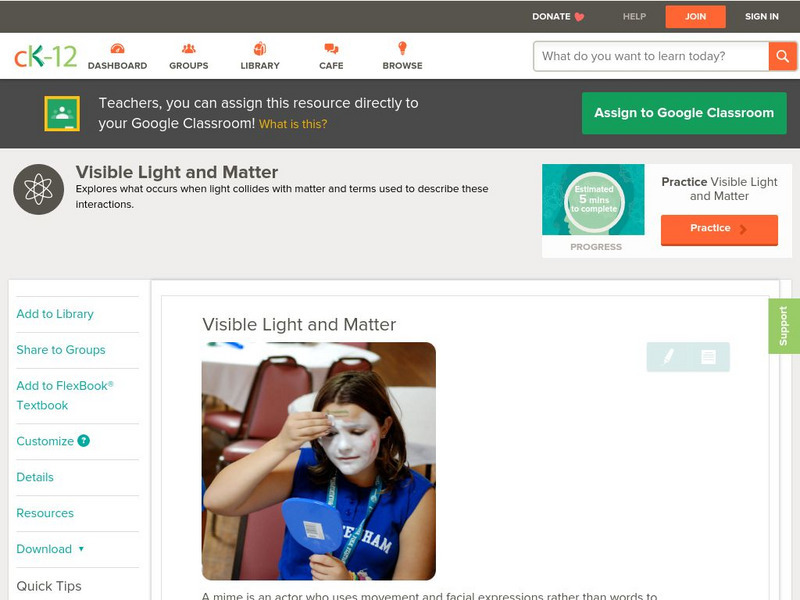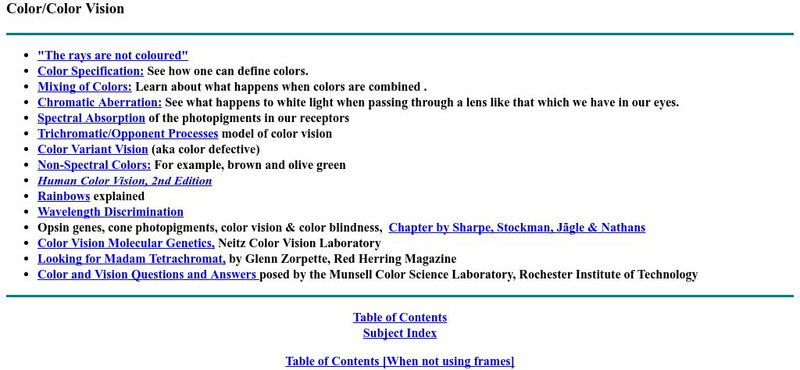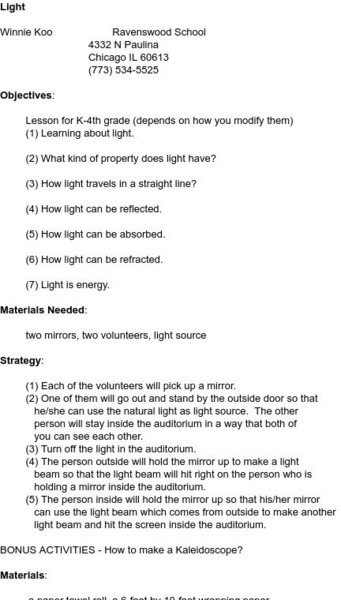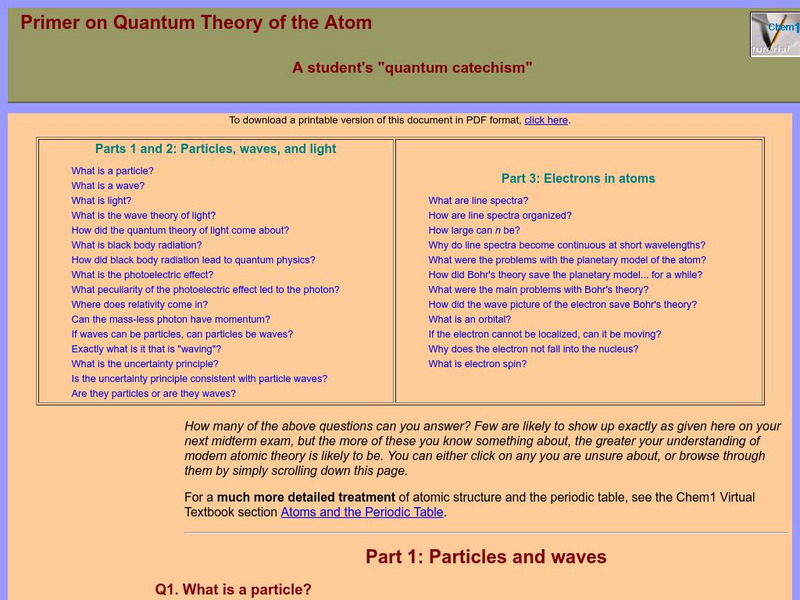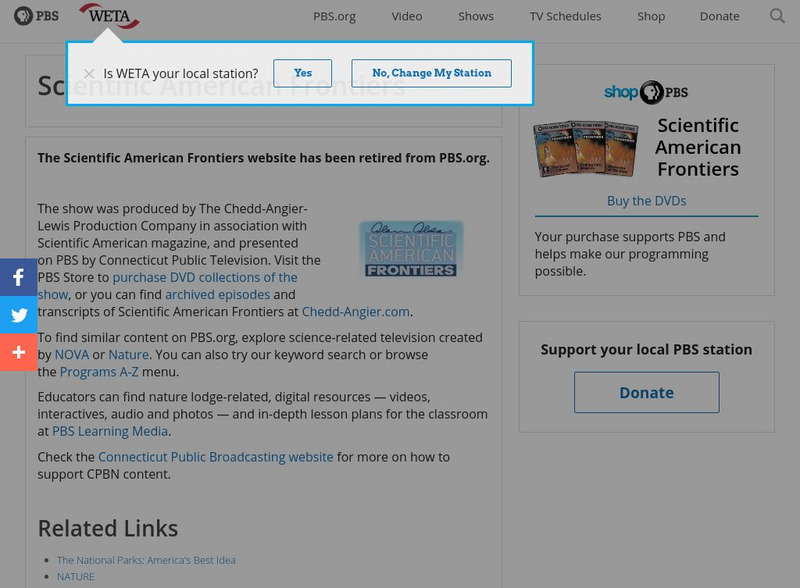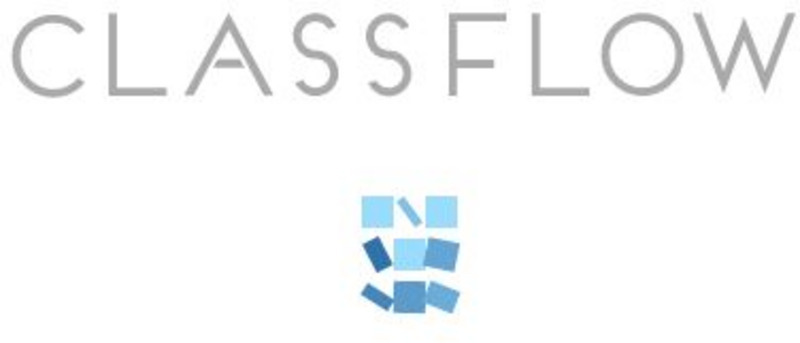Better Lesson
Better Lesson: Mira Mira the Amazing Mira
Using a mira, 4th graders draw symmetrical pictures and then explain how the mira works using what they know about reflection and the eye.
Project Britain
Primary Homework Help: Light and Shadows Quiz
This resource provides information about light and shadows. In addition, there is a short quiz that can be taken.
E-learning for Kids
E Learning for Kids: Science: North Sea: Why Do We Need Light?
Frederik is doing experiments about light to find out how it helps people to see things.
CK-12 Foundation
Ck 12: Physical Science: Visible Light and Matter
[Free Registration/Login may be required to access all resource tools.] How visible light interacts with matter and classifying matter in terms of light.
CK-12 Foundation
Ck 12: Physical Science: Law of Reflection
[Free Registration/Login may be required to access all resource tools.] Reflection and how it produces an image, regular and diffuse reflection and the law of reflection.
TED Talks
Ted: Ted Ed: Is Light a Particle or a Wave?
In this third part of his series on light and color, Colm Kelleher discusses wave-particle duality and its relationship to how we see light and, therefore, color. [4:23]
BBC
Bbc: Gcse Bitesize: Why Do Scientists Think That Light and Sound Are Waves?
Light travels as transverse waves and can travel through a vacuum. Sound travels as longitudinal waves and needs to travel through a solid, liquid or gas. Read about the properties of light and of sound, and learn the differences between...
CK-12 Foundation
Ck 12: Physics: Wave Optics Study Guide
A study guide for concepts related to wave optics.
PBS
Pbs Learning Media: Let's Explore Light: Lesson Plan
Young scholars will use observations and evidence to describe that objects can only be seen if they are illuminated by an external light source or give off their own light. Media is used to supplement student observations and encourage...
PBS
Pbs Learning Media: Bringing the Universe to America's Classrooms: Waves: Light Collection
Observe the appearance of objects under different conditions to find that objects are only visible when illuminated by light, explore how light interacts with different materials, and develop a code that uses light to communicate across...
NOAA
Noaa: Seeing Things Differently Using Polarization [Pdf]
Discover how polarizing filters can make certain objects more visible to the human eye.
York University
York University: Color and Color Vision
York University provides an index page to several other pages on the topic of color and color vision. The pages are part of an online "book." Many graphics and explanations.
University of Minnesota
University of Minnesota: How Does Light Travel?
Contains a four step procedure to deriving the law of reflection using algebra, Fermat's principle, and calculus (simple derivatives). This is good for an in-class theoretical exercise.
Science and Mathematics Initiative for Learning Enhancement (SMILE)
Smile: Light and Vision
Lesson plan should be used for intermediate students. Students work in pairs or groups to create a shoe box that will bend light.
Science and Mathematics Initiative for Learning Enhancement (SMILE)
Smile: Light (K 4)
This site provides two activities that young scholars can do in class. One uses mirrors to reflect light beams whole another is making a kaleidescope.
Simon Fraser University
Chem1 Virtual Textbook: What Is Light?
Acting as part of an overview on quantum theory, this section of the site answers the question, what is light? In answering the question, specific discussion is directed toward light waves and theories of light.
Simon Fraser University
Chem1 Virtual Textbook: Wave, Particle, or What?
Acting as a subtopic of the General Chemistry Virtual Textbook's section on Atoms and the Periodic Table, this site discusses light, waves, and particles. Part of the discussion involves a definition and working information on the...
Fundación Cientec
Cientec: Instrumentos Para Investigar La Luz
This site shows how to build different instruments to experiment with light. Step by step instructions with pictures are provided.
PBS
Pbs Teachers: Life's Big Questions: How Did the Universe Begin?
Investigate the Big Bang Theory of the origin of the universe by researching the light spectrum and the actions of light waves. Create models that illustrate red shift in a moving star and the expansion of the universe.
Sophia Learning
Sophia: Light Waves: Lesson 1
This lesson will introduce light waves and describe how a particle can travel as a photon or a wave. It is 1 of 4 in the series titled "Light Waves."
Sophia Learning
Sophia: Light Waves: Lesson 3
This lesson will introduce light waves and describe how a particle can travel as a photon or a wave. It is 3 of 4 in the series titled "Light Waves."
ClassFlow
Class Flow: Introduction Lesson on Light
[Free Registration/Login Required] This flipchart is an introduction lesson on light. It explains absorption, transmission, and reflection. It contains real pictures that allow students to see how matter in an object determines how much...
ClassFlow
Class Flow: Introduction to Light
[Free Registration/Login Required] This flipchart introduces fifth graders to the science of light. Principles such as transparent, translucent, opaque, reflection, and refraction are covered. Concave and convex mirrors and lenses are...
ClassFlow
Class Flow: Introduction to Light Waves
[Free Registration/Login Required] This flipchart is an introduction to light waves. It discusses a wave's crest, trough, amplitude and how to measure a wave.





